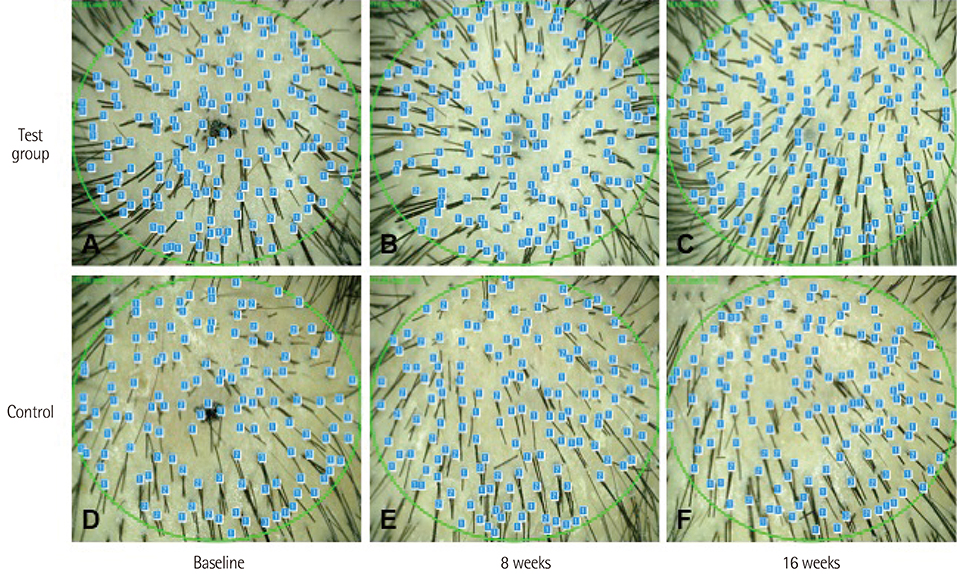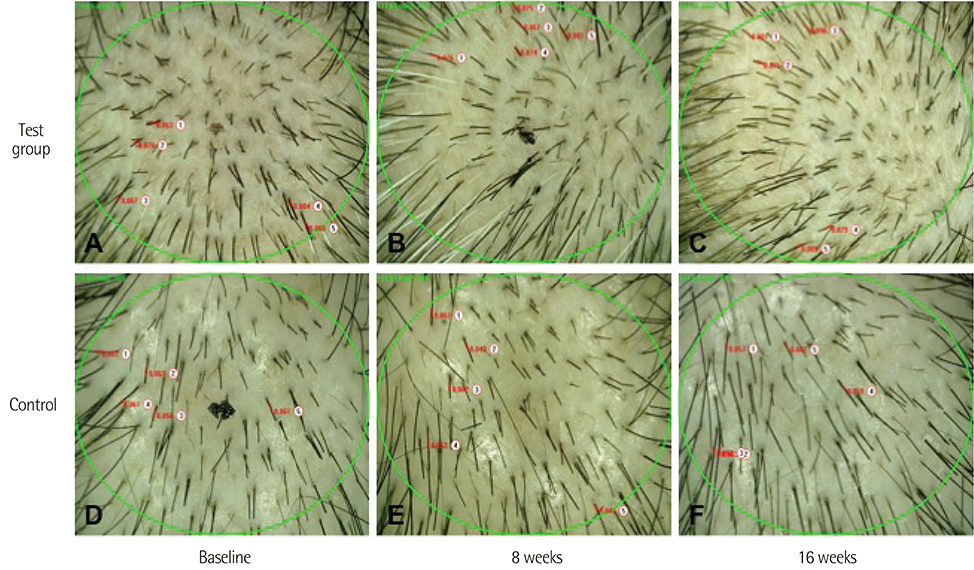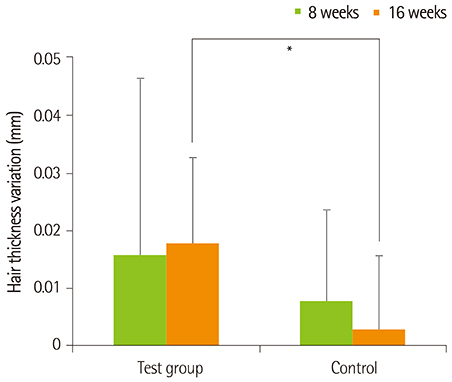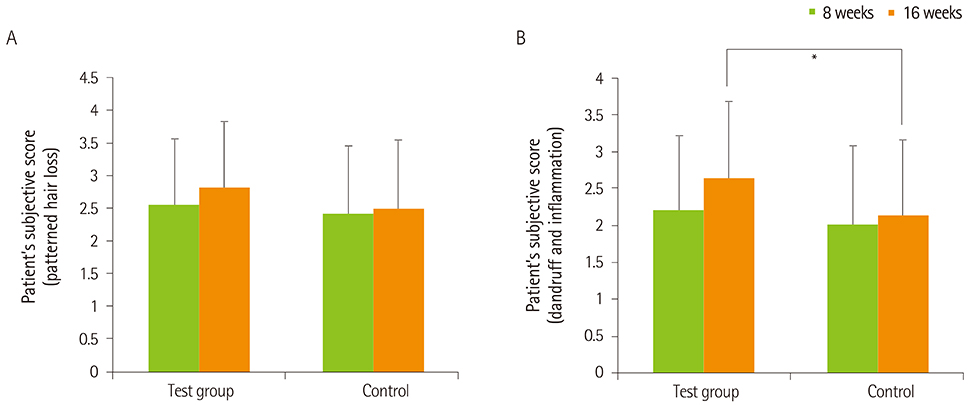Clin Nutr Res.
2015 Apr;4(2):124-131. 10.7762/cnr.2015.4.2.124.
Efficacy of Cistanche Tubulosa and Laminaria Japonica Extracts (MK-R7) Supplement in Preventing Patterned Hair Loss and Promoting Scalp Health
- Affiliations
-
- 1Department of Dermatology, Chung-Ang University College of Medicine, Seoul 156-755, Korea. beomjoon@unitel.co.kr
- 2Misuba RTech Co., Ltd., Asan 336-795, Korea.
- 3Department of Food and Nutrition, Hoseo University, Asan 336-795, Korea.
- KMID: 2279358
- DOI: http://doi.org/10.7762/cnr.2015.4.2.124
Abstract
- Cistanche tubulosa and Laminaria japonica have been reported to have anti-oxidative, anticoagulant, anti-cancer and anti-inflammatory properties. They are expected to be a promising candidates for promoting hair growth and treating dandruff and scalp inflammation as a consequence. In this double-blinded, placebo-controlled clinical trial, we investigated the efficacy of Cistanche tubulosa extract and Laminaria japonica extract complex (MK-R7) in promoting hair health in patients with mild to moderate patterned hair loss. Using phototrichogram (Folliscope 4.0, LeadM, Seoul, Korea), we compared the density and diameter of hairs in patients receiving a placebo or Cistanche tubulosa extract and Laminaria japonica extract complex (MK-R7) at baseline, 8 and 16 weeks of the study. In order to determine the efficacy of treatment on dandruff and scalp inflammation, investigator's assessment score and patient's subjective score were also performed. We found a statistically significant increase in the hair density of the test group (n = 45, MK-R7 400 mg) after 16 weeks of consuming the MK-R7 (test group: 23.29 n/cm2 +/- 24.26, control: 10.35 n/cm2 +/- 20.08, p < 0.05). In addition, we found a statistically significant increase in hair diameter in the test group compared to control group at week 16 (test group: 0.018 mm +/- 0.015, control: 0.003 mm +/- 0.013, p < 0.05). There were also significant outcomes regarding the investigator's visual assessment and patient's subjective score of dandruff and scalp inflammation in the test group compared to those in control group. Based on the results of this clinical study, we conclude that Cistanche tubulosa extract and Laminaria japonica extract complex (MK-R7) are promising substances for promoting health of the scalp and hair.
Figure
Reference
-
1. Hwang YS. Hair loss. Korean Ind Chem News. 2007; 10:40–41.2. Buhl AE, Waldon DJ, Baker CA, Johnson GA. Minoxidil sulfate is the active metabolite that stimulates hair follicles. J Invest Dermatol. 1990; 95:553–557.
Article3. Kaufman KD, Dawber RP. Finasteride, a type 2 5alpha-reductase inhibitor, in the treatment of men with androgenetic alopecia. Expert Opin Investig Drugs. 1999; 8:403–415.
Article4. Anitha B, Inamadar AC, Ragunatha S. Finasteride-its impact on sexual function and prostate cancer. J Cutan Aesthet Surg. 2009; 2:12–16.
Article5. Feldman SC, Reynaldi S, Stortz CA, Cerezo AS, Damont EB. Antiviral properties of fucoidan fractions from Leathesia difformis. Phytomedicine. 1999; 6:335–340.
Article6. Wang J, Zhang Q, Zhang Z, Song H, Li P. Potential antioxidant and anticoagulant capacity of low molecular weight fucoidan fractions extracted from Laminaria japonica. Int J Biol Macromol. 2010; 46:6–12.
Article7. Bojakowski K, Abramczyk P, Bojakowska M, Zwolińska A, Przybylski J, Gaciong Z. Fucoidan improves the renal blood flow in the early stage of renal ischemia/reperfusion injury in the rat. J Physiol Pharmacol. 2001; 52:137–143.8. Li N, Zhang Q, Song J. Toxicological evaluation of fucoidan extracted from Laminaria japonica in Wistar rats. Food Chem Toxicol. 2005; 43:421–426.
Article9. Min SK, Han SM, Kim HT, Kwon OC, Lee S, Kim JK. Algal fucoidan, unlike heparin, has thrombolytic activity in a murine arterial thrombosis model. Blood Coagul Fibrinolysis. 2012; 23:359–366.
Article10. Min SK, Kwon OC, Lee S, Park KH, Kim JK. An antithrombotic fucoidan, unlike heparin, does not prolong bleeding time in a murine arterial thrombosis model: a comparative study of Undaria pinnatifida sporophylls and Fucus vesiculosus. Phytother Res. 2012; 26:752–757.
Article11. Yamada P, Iijima R, Han J, Shigemori H, Yokota S, Isoda H. Inhibitory effect of acteoside isolated from Cistanche tubulosa on chemical mediator release and inflammatory cytokine production by RBL-2H3 and KU812 cells. Planta Med. 2010; 76:1512–1518.
Article12. Kyung J, Kim D, Park D, Yang YH, Choi EK, Lee SP, Kim TS, Lee YB, Kim YB. Synergistic anti-inflammatory effects of Laminaria japonica fucoidan and Cistanche tubulosa extract. Lab Anim Res. 2012; 28:91–97.
Article13. Shimoda H, Tanaka J, Takahara Y, Takemoto K, Shan SJ, Su MH. The hypocholesterolemic effects of Cistanche tubulosa extract, a Chinese traditional crude medicine, in mice. Am J Chin Med. 2009; 37:1125–1138.
Article14. Giraux JL, Tapon-Bretaudière J, Matou S, Fischer AM. Fucoidan, as heparin, induces tissue factor pathway inhibitor release from cultured human endothelial cells. Thromb Haemost. 1998; 80:692–695.15. Headington JT. Hair follicle biology and topical minoxidil: possible mechanisms of action. Dermatologica. 1987; 175:Suppl 2. 19–22.
Article16. Vayá A, Sarnago A, Ricart JM, López V, Martinez M, Laiz B. Inflammatory markers and Lp(a) levels as cardiovascular risk factors in androgenetic alopecia. Clin Hemorheol Microcirc. 2014; Forthcoming.
Article17. Sadighha A, Zahed GM. Evaluation of lipid levels in androgenetic alopecia in comparison with control group. J Eur Acad Dermatol Venereol. 2009; 23:80–81.
Article
- Full Text Links
- Actions
-
Cited
- CITED
-
- Close
- Share
- Similar articles
-
- Effectiveness of the combinational treatment of Laminaria japonica and Cistanche tubulosa extracts in hair growth
- Synergistic anti-inflammatory effects of Laminaria japonica fucoidan and Cistanche tubulosa extract
- Finasteride Treatment of Female Patterned Hair Loss in Postmenopausal Women
- Comparative analysis of anti-Helicobacter pylori activities of FEMY-R7 composed of Laminaria japonica and Oenothera biennis extracts in mice and humans
- Erratum: Synergistic anti-inflammatory effects of Laminaria japonica fucoidan and Cistanche tubulosa extract







